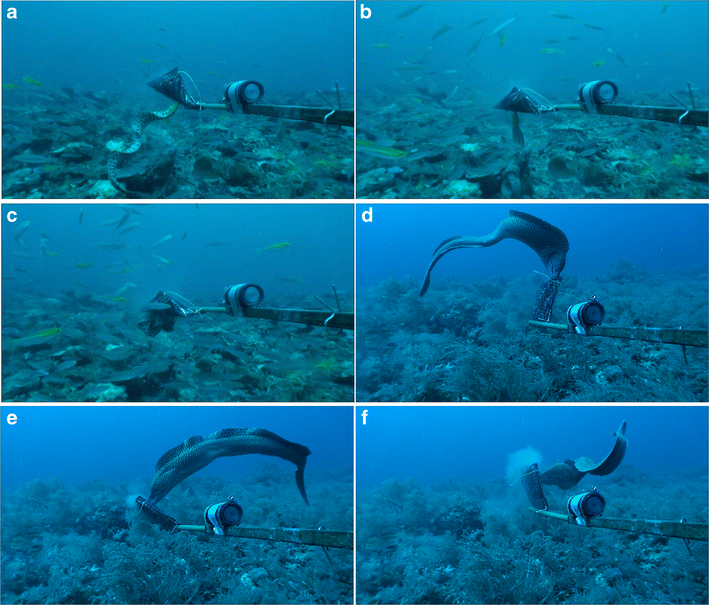You ain’t seen knotting yet! Novel feeding behaviours in moray eels
01
KNOTTY EELS
Moray eel behaviours at Scott Reef. Gymnothorax fimbriatus attacks the bait bag (a), forms a “knot” in its tail (b), and rapidly pushes the knot into the bait bag (c). A different moray eel, Gymnothorax favagineus, attacks the bait from two angles (d, e) before using its tail as a “paddle” to rip open the mesh bag (f) (Barley et al. 2015).
CITATION
Barley SC, Mehta RS, Meeuwig JJ, Meekan MG. 2015. To knot or not? Novel feeding behaviours in moray eels. Marine Biodiversity. DOI: 10.1007/s12526-015-0404-y
ABSTRACT
We report observations of a novel feeding behaviour in the moray eel Gymnothorax favagineus (Bloch & Schneider, 1801) and a previously undocumented application of “knotting” behaviour in G. fimbriatus (Bennett, 1832). Moray eels were filmed by baited remote underwater video systems (BRUVS) at the Scott Reefs, a remote group of atoll-like reefs on the edge of the continental shelf in tropical, northwestern Australia. Two behaviours were observed as the moray eels tried to dislodge food from a bait bag: (1) G. favagineus used its tail as a “paddle” to gain leverage on the bag, and (2) G. fimbriatus tied a knot in its tail in order to extract food from the bag. Our observations suggest that morays have an extensive behavioural repertoire for manipulating and extracting large prey items from the interstices of the reefs where they typically hunt.
FUNDING & ACKNOWLEDGEMENTS
We would like to thank the Australian Institute of Marine Science for the use of its research vessel, the RV Solander, and for the support of its crew. We also acknowledge the Department of Fisheries, the Department of Parks and Wildlife (DPaW) and the Department of Sustainability, Environment, Water, Population and Communities for arranging permits to conduct research at the Scott Reefs. Experimental protocols were approved by the University of Western Australia’s Animal Ethics Committee (RA3/100/1279, RA3/100/1172), and were carried out in accordance with the approved guidelines.

